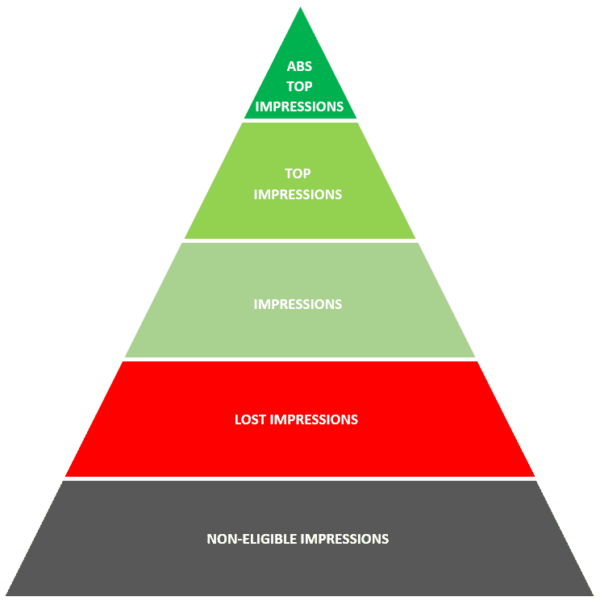As a SEA campaign manager, you follow up closely on Search Impression Share on a regular basis in order to get insights into the evolution of searches and on the visibility of your ads.
As we will see in this article, even if you reach 100% Search Impression Share in your campaigns you might be missing potential impressions as they were identified as not eligible by Google. In this case, there’s no way to know how many impressions we are indeed missing and it is relevant to wonder if SIS is a reliable metric or not.
What is Search Impression Share and how is it calculated?
Let’s get back to basics and refresh your memory a bit. The term Search Impression Share is defined as “the number of impressions you have received, divided by the approximate number of impressions you were eligible to receive”.
The formula to calculate impression share is pretty straightforward, however, one of the components remains a bit vague: the total eligible impressions.
Impression share = impressions / total eligible impressions
According to Google: “Eligible impressions are estimated using many factors, including targeting settings, bids, approval statuses, and quality. Impression share data is available for campaigns, ad groups, product groups (for Shopping campaigns), and keywords.”
Are all impressions the same?
There are 3 types of impressions according to the position of your ads on the page: absolute top impressions, top impressions, and impressions. Including “Lost impressions” and “Not eligible impressions”, we can divide impressions into 5 categories.
- Absolute top impressions: Search absolute top impressions are the impressions you’ve received in the absolute top location of the page, the old position 1.
- Top impressions: Search top impressions are the impressions you’ve received in the top location, anywhere above the organic search results, and are including absolute top impressions.
- Impressions: Search impressions are all the impressions you’ve received no matter where the location of your ads is.
- Lost eligible impressions: Search lost impressions are all the impressions you were eligible to, but lost the auction either because of budget or rank.
- Non-eligible impressions: Search impressions that Google identified as not eligible to participate in the auction.

The position and eligibility of your ads are defined by your Ad Rank which is calculated using your bid amount and your auction-time quality score (including expected clickthrough rate, ad relevance, and landing page experience). The higher your ad rank is, the higher your position of your ad will be on the page.
When you lose search impression share due to Ad rank, it means that your Ad Rank is not competitive enough for your ad to be shown, but you still have access to the Auction Insights (report lets you compare your performance with other advertisers who are participating in the same auctions that you are) as you are still participating in the auction.
But if Google identifies that your ad is not relevant enough, you may end up not being eligible to participate in the auction and therefore you will lose all the insights on the potential impressions available on the market.
What is the impact of bidding strategies on impressions?
When using a smart bidding strategy, for example, you let Google’s algorithms optimize your bids in order to achieve a specific objective which can be a Target Search Impression Share, a Target ROAS, or a Target CPA. You can also ask Google to achieve a maximum number of clicks or conversions following the budget using respectively Maximize Clicks or Maximize Conversions bidding strategies.
Google is optimizing on way more parameters than a keyword list only and as your smart bidding strategy is trying to reach a specific goal that is not the total eligible impressions, your ads won’t be entered into the auction if certain combinations of parameters are met as the smart bidding strategy might think it won’t contribute to the goal it’s trying to reach.
This means that some keywords/queries won’t be a part of the auction so not eligible for impressions. Not because the keyword is not performing, but rather because one or a combination of parameters has been identified as not eligible for an impression.
Google doesn’t really give a lot of information on how your smart bidding strategy is impacting your search impression share. But in some cases, you can get insights on top signals that influence the smart bidding strategies in your portfolio bid strategy.

When you use smart bidding, it may not be very useful to look at Search Impression Share as a way to measure the total potential.
For example, when you’re making budget projections for future months or years to come, knowing what the total potential of impressions would be a valuable piece of information. But we can not really estimate what the total of potential impressions would be if we wanted to appear for all of them when using smart bidding (regardless of the type of smart bidding strategy that you choose).
Case of the impact of bidding on eligible impressions
We switched the bid strategy and conversion setting for one of our branded campaigns. It used to be a target CPA focused on an upper-funnel conversion.
With this target CPA & conversion setting came a search impression share of 99% and a total of 12.298 impressions. When we changed the bid strategy to a target CPA focused on a lower-funnel conversion we saw a few drops on certain metrics.

When we made a change in the bid strategy and conversion settings, the target CPA reduced its bid because it would attain fewer conversions at a higher CPL (which was expected due to the conversion setting change). With this change, the smart bidding algorithm decided that a big part of the eligible impressions we got before is now no longer eligible.
This could also be found when the opposite happens and we increase the bid. Let us say you have a campaign that has an 80% impression share with a 20% impressions share lost due to rank.
According to Google: “Eligible impressions are estimated using many factors, including targeting settings, bids, approval statuses, and quality. Impression share data is available for campaigns, ad groups, product groups (for Shopping campaigns), and keywords.”
With this definition in mind, we break down the different steps that happen when taking action to increase bids.
Looking at the formula we know that the standard situation is
Standard situation:
80% = impressions / total eligible impressions
Increased bid situation:
80% + X% = impressions + Y / total eligible impressions
However, according to Google, bids can also impact which impressions are eligible. This would mean that the following “formula” is true
Increased bid situation:
80% + X% = impressions + Y / total eligible impressions + Z
Because one of the levers to impact Impression share (bids) affects both parts of the calculation, it’s hard to really compare two impression share percentages after a change like this was made.
By making this change, it’s possible Google decides that a huge bucket of impressions becomes eligible. In the example above, if the proportional change in impressions is smaller than the proportional change in eligible impressions, then the SIS will decrease, while you’ve actually achieved your goal in getting more volume.
With this situation described above, it’s hard to use SIS as a measure of total potential or to make budget estimations as the SIS metric shows the situation at that point in time, using the current (bidding) settings.
As a result, comparing two impression share percentages when a change has been made to any parameter that could influence total eligible impressions and the impressions you actually win does not make much sense.
Conclusion
As we have seen in this article, only looking at Search Impression Share metrics to draw conclusions on the visibility of your ads might be misleading as your total eligible impressions could be influenced by many factors such as your bidding strategy, competition on keywords, and the quality of your ads.
In the end, you never know the proportion of impressions Google has identified as non-relevant and therefore you never have access to the total potential of impressions which would be a valuable piece of information. As we experienced in our different accounts and as illustrated in this article via the use case, applying a new bidding strategy may have an important impact on the potential impressions your ads are eligible for.
In case of major changes on bidding, we recommend to monitor the volume of impressions generated before and after the change and calculate the new total eligible impressions to see if there has been a major change in the “buckets” of auctions or impressions that Google deems eligible.
Finally, we recommend being cautious when comparing the Search impression share between two periods when changes have been made that can have an impact on this.
Get our ramblings right in your inbox
We deepdive into hot topics across digital marketing and love to share.


